Praey for the Gods' First Boss Architectural Critique.
Games like Shadow of the Colossus and Praey for the Gods stretch and bend the meaning of architecture. In each of these games the primary obstacles are towering giants lumbering ominously. In order to defeat these moving skyscrapers, we must scale these bodies of these behemoths.
I consider these beings architecture for three reasons:
They are integral to the atmosphere and experience of the player.
The scale of the beings is more similar to a building than it is to anything that human beings experience.
They are clad in various materials and often include floors and rooms.
I fully admit that these reasons aren’t particularly convincing, but I don’t think there is a particularly convincing argument for them NOT being architecture.
I’m almost 100% positive that there is no physical way that this being could support itself. The legs are far too thin. There is also a chunk missing out of the body to allow the player to catch their breath. The fact that the giant still FEELS physically real despite the fact that I KNOW it couldn’t possibly exist is a credit to the design of the rest of the structure.
The body appears to be crumbling in places, as if it were made of stone. The missing chunk from the body is crowned with an arch that feels materially appropriate. The fur coating the legs and back is such a unique building material, I’d love to see a material with a shared aesthetic used more often. The skull at the top of the structure beautifully caps the moving ruin.
The level is nicely designed with three interactive nodes obviously exposed. They are located near the natural paths of ascension. There is a mid point that you can easily grapple back to if you get tossed (I did, I’m not very good at this game). None of it felt out of place and none of it distracted from the expertly designed atmosphere. As the snow flurried around me as I climbed this giants furry back, I sunk into a calmness that I did not expect.
It’s clear that Praey for the Gods is cultivating a potent cold, lonely experience. The combination of ancient Nordic fashion and moving stone ruin fully fleshes out that experience and I can’t wait to see how the rest of the designs fit into this world.






